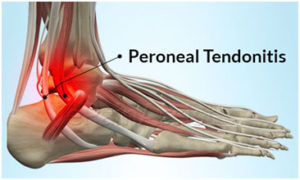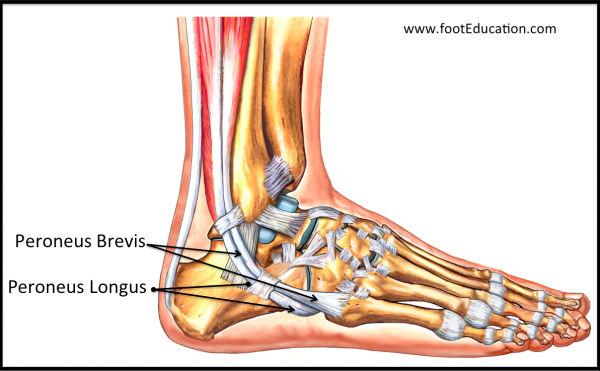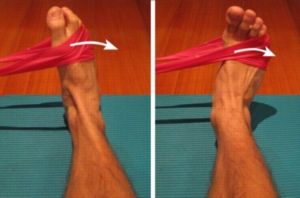Peroneal Tendonopathy
Posted on July 11th, 2019 by Andries Lodder

Are you suffering from pain on the outside of your foot while running, walking or jumping? If the pain is directly behind the little bone that sicks out on the outside of your ankle, then you could have Peroneal Tendonopathy.
Peroneal Tendonopathy occurs when the Peroneal Tendons become inflamed. This can be due to an increase in load or overuse of the tendons which leads them to rubbing on the bones of the ankle and becoming inflamed. Overtime the tendons will thicken to try and compensate for the increased load, leading to further inflammation.
Anatomy:
There are two Peroneal tendons in each leg. They run down the outside of the lower leg and behind the lateral malleolus of the ankle (bony bump on the outside of the ankle).

One tendon attaches on the outside of the foot at the base of the baby toe, while the other goes underneath the foot and attached underneath the arch. These tendons provide stability to the ankle and protect the joint from sprains. They also assist in turning the foot outwards and in stabilizing the arch of the foot.
Causes:
Any activity that involves excessive ankle movement can lead to Peroneal tendonopathy. However, it is especially common in runners who supinate and roll their feet outwards leading to pressure being placed on these tendons and causing it to rub on the malleolous in the ankle.
Risk factors:
- Overuse
- A sudden increase in training
- Poor footwear
- Poor biomechanics of the lower leg
- Muscle imbalances
- Individuals with a high arch in their foot
Signs and Symptoms:
Peroneal tendonopathy can be either acute, meaning it develops very suddenly usually following a specific traumatic event or more commonly, it can be chronic and develop over time.
Symptoms:
- Pain behind the lateral malleolus
- Pain at the back of the ankle
- Pain when turning the foot out
- Pain during and after weight bearing activities, such as running
- Ankle instability
- The skin at the back of the ankle will be warm to the touch due to the inflammation
Diagnosis:
A medical professional will use an individual’s history to determine if they have the risk factors and symptoms of Peroneal Tendonopathy. A variety of movement and biomechanic tests can also be done by a physiotherapist or Biokineticist to determine if the tendons are inflamed.
A CT scan or MRI might be necessary to rule out any tendon ruptures or other abnormalities in certain cases.
Treatment:
Since the tendons are inflamed due to overuse, rest will be essential in helping reduce the inflammation, swelling and pain. Therefore, only non-weight bearing activities should be done for the first few days and weeks depending on severity. Anti-inflammatory drugs can be taken to help with any pain if prescribed by a medical professional.
Initially the best treatment is rest, ice, compression and elevation in order to allow the tendons time to recover.
After which a exercise program should be started in order to correct any biomechanical abnormalities or muscles imbalances. Exercises to strengthen the peroneal muscles and tendons should be performed, as well as ankle stability exercises. If the individual is a runner then their running style and technique should be checked and corrected if necessary. Their footwear should also then be checked to see if it is appropriate.
Exercises:
Single leg balancing:
- Stand on one leg with the supporting knee a little bit bent
- Ensure your hips stay in line and that the arch of your foot does not collapse
- Balance for as long as possible
- To make this exercise more effective it can also be done on an airex mat or balance pad
- Balance for 30 – 60 seconds per leg for three to four rounds
- Arm, head and eye movements can also be added to make this exercise more challenging

Ankle Eversion exercises:
- Place a Thera band or loop around your foot
- Pulling from the ankle only turn your foot outwards
- Ensure your leg and knee do not move and that only your ankle turns
- Do 3 sets of 10- 20 repetitions per leg

Calf stretches:
- Standing with one leg forward and bent and the other straight out behind you
- Keep the feet straight forward and the both heels pushed into the ground
- Bent forward to stretch the Gastrocnemius muscle of the calf of the back leg
- Hold this stretch for 30 seconds
- Then bend the back knee and sit back into the back leg to stretch the Soleus muscle of the calf
- Hold this for 30 seconds
- Repeat this twice per leg


For more information or to book an assessment if you think you could be suffering from Peroneal Tendonopathy do not hesitate to contact us.
Tweet